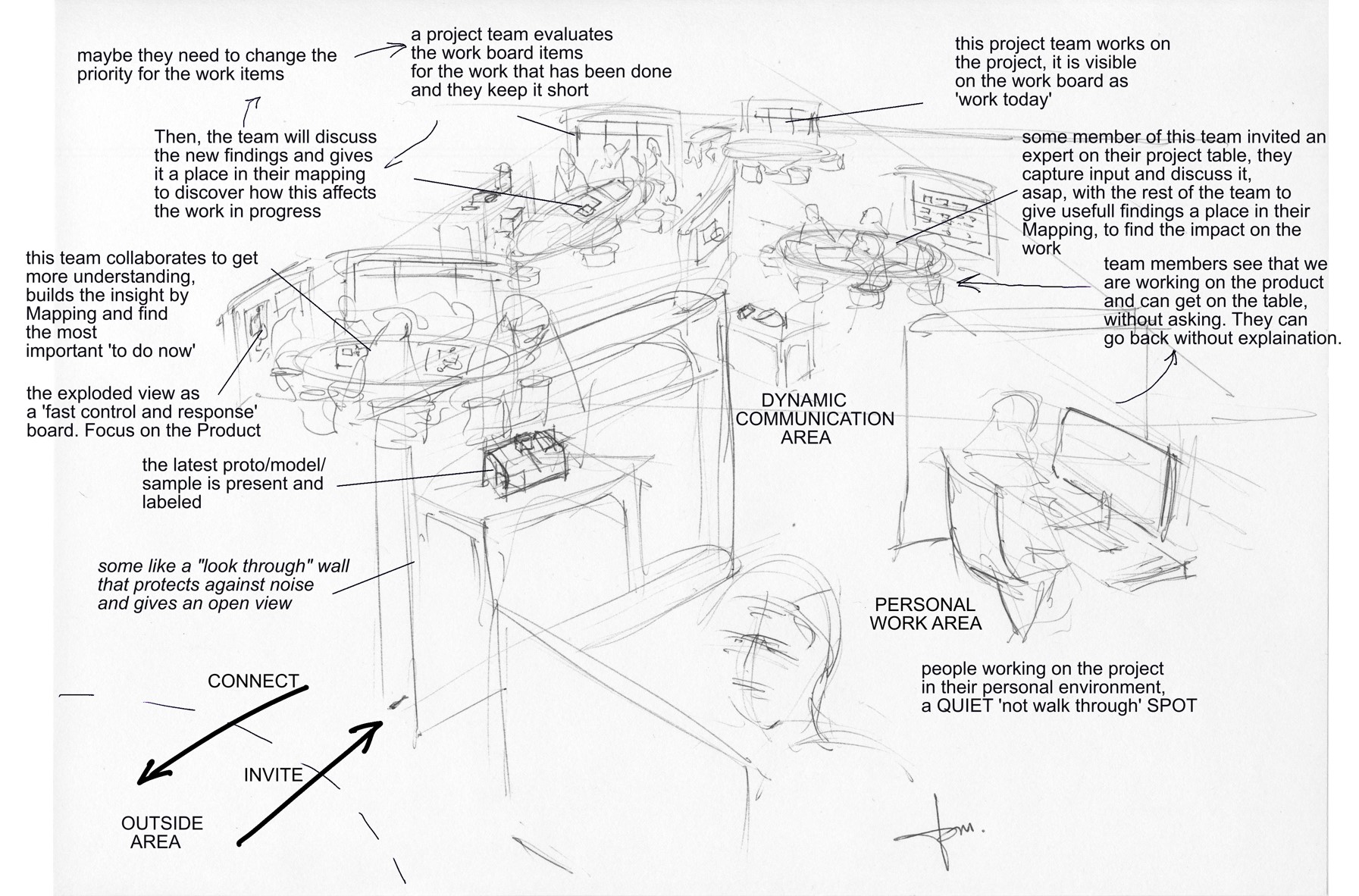from original goole blog – 24 Mars 2013
Imagine a project management approach that feels like coming home or being invited to someone’s table. Just like when you visit someone’s home, you can sense the unspoken rules and habits of that culture, and out of respect, you behave accordingly. The concept of Project Tables is based on this idea, aiming to create a harmonious work environment where different cultures, such as development and production, can coexist and thrive.
The Project Tables concept originated in the spring of 2007, with the purpose of providing a dedicated space within the work landscape for both development and production teams. Even today, it remains a viable option for fostering a positive work environment in product development.
So, what exactly are Project Tables? They are highly visible project areas specifically designed for product development projects. They have their own distinct culture and serve as a focal point for communication, collaboration, and individual or group work. Project Tables are primarily intended for people in product development.
The need for Project Tables arises in situations where effective communication between team members and invited experts is crucial, and where individuals or groups need to work on specific project tasks. These tables are typically used in projects related to product development, either integrated into other working cultures like production and marketing, or set up exclusively for development purposes.

Now, let’s explore why Project Tables can be beneficial for project leaders and their teams:
- Mindset of involvement and responsibility: Project Tables help create a mindset where everyone feels involved and responsible for the success of the project.
- Protection for the team: By implementing Project Tables, the hierarchical structure is minimized, and the team is shielded from unwanted interference or overrides from “bosses.” This promotes a sense of autonomy and empowerment.
- Equal importance to all: Project Tables ensure that every individual involved in the project is treated as equally important, regardless of their role or position.
- Collating Design and Engineering cultures: These tables provide a space where the Design and Engineering cultures can come together, fostering collaboration and synergy between these essential aspects of product development.
- Focused on serving the user: Project Tables enable teams to be assigned to projects with a specific focus on serving the end-user, ensuring that the product meets their needs and expectations.
- Enhanced visibility across projects: Project Tables allow teams to see and understand other ongoing projects within the organization. This awareness promotes collaboration, learning, and the ability to anticipate potential challenges.
- Optimized communication and collaboration: Project Tables facilitate face-to-face communication and collaboration, providing a natural and efficient way for team members to interact and exchange ideas.
- Autonomous teams: By embracing the Project Tables approach, teams are encouraged to self-organize, fostering autonomy and promoting collective problem-solving.
- Building trust: The physical presence of Project Tables and the transparent nature of the work being done within them can help build trust among team members and stakeholders.
- No more problems with meeting room reservations: With dedicated project areas like Project Tables, there is no longer a need to worry about booking meeting rooms for project-related discussions and collaborations. This streamlines the process and avoids conflicts over limited meeting space.
- Structured collaboration: Project Tables promote spontaneous and structured collaboration. When someone says, “Get on the table,” it signifies an invitation to contribute and collaborate, fostering agile decision-making and problem-solving.
- Small core teams: Project Tables emphasize the formation of small core teams, enabling effective communication and decision-making within a manageable group.
- Watching the product, not the worker: The focus shifts from monitoring individuals to paying attention to the product itself, fostering a results-oriented work environment.
- Minimizing interruptions: Project Tables discourage interruptions and disturbances at personal workstations, allowing individuals to concentrate on their tasks without unnecessary distractions
To implement Project Tables, teams are assigned a physical table that represents their project. The tables are placed in a designated project area alongside other Project Tables. Each table is equipped with visual attributes that serve specific functions, such as an oval-shaped table that symbolizes equality, chairs representing different roles, a fast response and control board for tracking objectives and metrics, work action and issues boards (e.g., Scrum or Kanban boards) to visualize progress, and an actual model or prototype presentation area.
To ensure smooth operation, a set of game rules governs the use of Project Tables. These rules include starting each day with a 10-minute project start meeting to share progress and organize tasks, emphasizing the importance of documenting work items, restricting access to the workspace to only team members, and encouraging a clutter-free environment through visual mapping techniques.
In addition to these practical aspects, Project Tables foster a dynamic and collaborative work culture. They encourage an attitude of sharing ideas, taking responsibility, and being open to constructive criticism. Invited guests can provide their insights and expertise, and the team can decide how to incorporate them. Even when team members are absent, their photos can be placed on the table, symbolizing their continuous presence and involvement.
In conclusion, Project Tables offer project managers a unique and effective approach to managing projects in a way that promotes collaboration, responsibility, and a user-centric mindset. By implementing this concept, project managers can create a productive work environment where teams can thrive, communicate effectively, and deliver successful products
read related posts:
Project- tables, the cockpit for development
How to set up and run a project. The Project Table set up for core team professionals.
You need ‘ProjectTable-core teams’ that manage autonomously for product/service and system development.
Training: ‘Project-Table’ setting an approach to set up and run projects.
